#semi aquatic dinosaur
Text
if someone taught me about dinosaurs i think i would fall in love with them on the spot
#My favourites are spinosaurus (interesting) and therazinosaurus (Turkey with acryllics)#spinosaurus being semi aquatic is the most basic and interesting thing i know i go feral everytie im reminded of it#if there was like. a david attenborough for each dinosaur i would eat thay shit up#even tho that would take decades at least#idk!!! i like dinosaurs!!!!#apollo says stuff#*therizinosaurus. knew i spelt it wrong#dinosaur talk
2 notes
·
View notes
Text
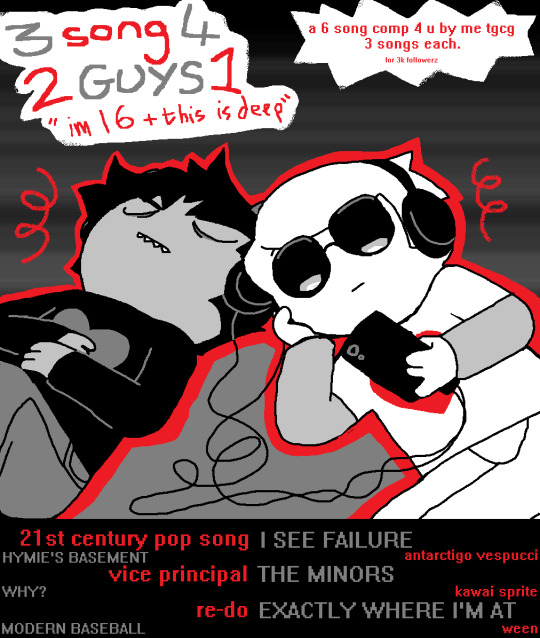
listen here on youtube
so first of all thanks for 3,000 followers. holy shit. thats 3000 more than i expected so thanks
i really didnt think this blog would get to this point when i made it. and im never gonna get over how kind and encouraging you guys have been for me. unending respect & gratitude guys.
we're closin in on the end of 2023 now and im resolving to keep doing right by you guys and having fun running this blog with yall 🙂 thanks forever
i wanted to do somethin special for it and i thought id share one of my biggest inspirations for interpretin davekat. which is music i think they'd like. when you routinely blast davekat doodles onto mspaint canvases at 2am you need a backing track and these are common choices for me
3 songs for each dude for 3k fwlrs. man thats crazy...
tracklist + lil commentary under readmore
dave zone
1... 21st century pop song -- hymie's basement
this whole album i associate with dave a lot even tho its very depresse mode. i have way too many plays on this song. that beat is so real.
2... vice principal -- why?
that record scratch bit got me bouncing&trouncing manm. ive been listening to this song since i was a lil shitty kid. this voice is my headcanon voice for dave
3... re-do -- modern baseball
get a load of them lyrics son. passage of time, dinosaurs, trouble sleeping, watching movies, fear of death, love of life. recent fave, big fave.
KARKAT ZONE
4... i see failure -- antarctigo vespucci
another new beat 4 me but damn its an anthem. love dudes who shout. self fulfilling prophecies of relationship failure are peak karkat 2 me
5... the minors -- kawai sprite
i have never played friday night funky. i found this album by pure fuckin chance and its great, if you like this song give it a shot. sounds adult swim-y. i associate a lot of songs from this album with kk its a very distinct sound that i just connect with him fsr. the bittersweet sad anger of it
6... exactly where i'm at -- ween
this is a certified karkat classic 4 me. "look at yourself your lips are like 2 flabs of fat, they go front and back and flappity flappity flap". one of my fave things about ween is they have really vivid lyrics and rlly consistently hit this cool spacey, semi-aquatic vibe. i think this is because of drugs that they are awesome, so lets all do more druggs today
562 notes
·
View notes
Text
April Fool's Day art for My S-Class Hunters by 비완
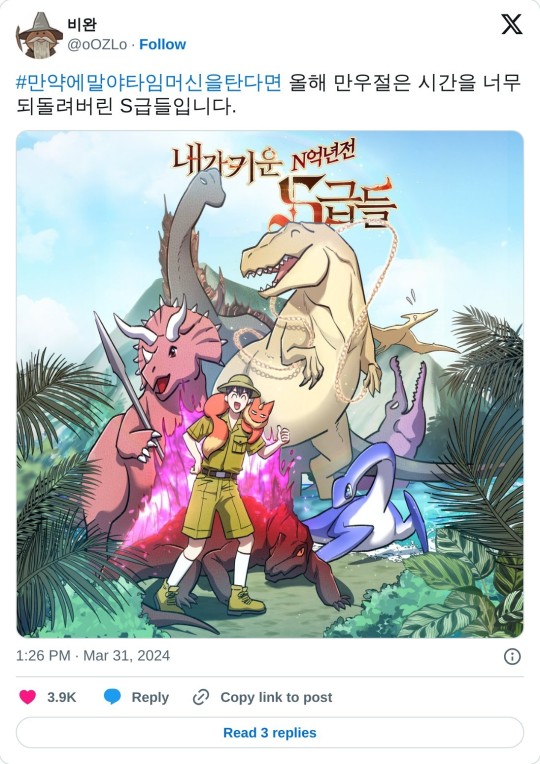
The manhwa artist for My S-Class Hunters made some April Fool's Day art: "This year's April Fool's Day, the S-Class turned back time too much." The head of storyboarding for the manhwa, serikachan, explained the different animal choices in this thread:
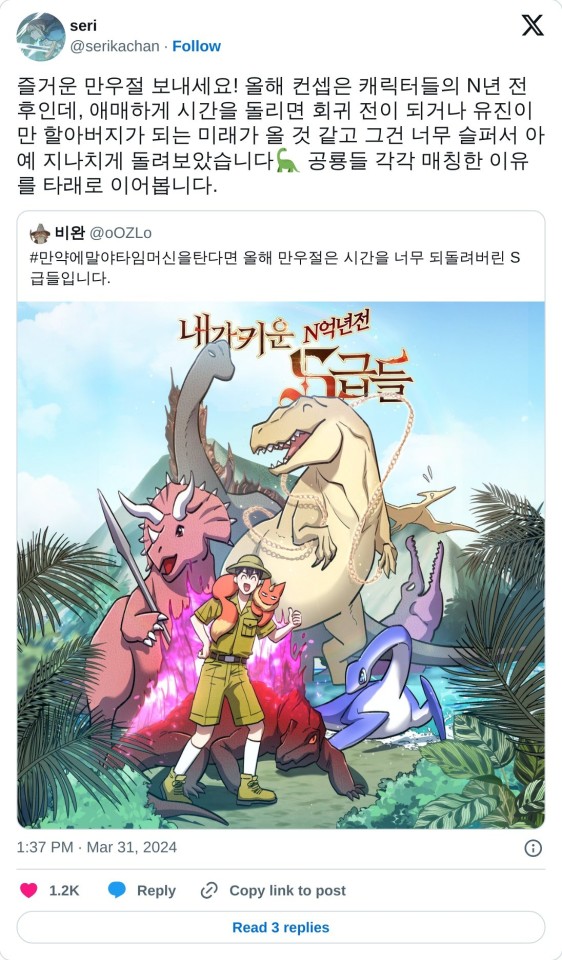
Machine English translation: "Have a good April Fool's Day! This year's concept is around the N years of the characters, but if I vaguely turn back time, it seems like there will be a time before the regression or a future where only Eugene becomes a grandfather, and that was so sad that I turned it around too much [dinosaur emoji] I'm going to follow the thread of the reason why I matched each dinosaur.
Seong Hyun-je is the world's strongest character at the time of the story, so he naturally became a Tyrannosaurus. I wonder if only Jo Gu can swing the chain with his front paw… Me: How many claws did the Tyranno have? Who gets angry if you get confused? Biwan: I need to put three conditions on Yujin, so I need three fingers. ??? : Oh shit!!! This is an Allosaurus!!!
Yoohyeon is Dimetrodon. Dimetrodon looks like a dinosaur, but it is not actually a dinosaur. It often appears as a fire attribute in other media (Hellfire Dimetrodon in WoW too…), so I thought it would be the best fit. At first I thought it was Charmander, but I couldn't tell it apart from Irene. [laughing face emoji]
Yerim was torn between Spinosaurus, which is very strong and lived a semi-aquatic life, and Plesiosaurus, a plesiosaur, but went with the latter for a more intuitive visual.
In many works, Spinosaurus and Tyrannosaurus are often paired 1:1, so I thought about having Director Song, who is currently fighting Hyeonje in the free game, take on the role of Spinosaurus, but I needed a dinosaur that would give a presence in the distance, so I decided on Brachiosaurus. It is done. Chew the lettuce well and enjoy the huge brachio song director…
Hyuna is a triceratops. The horns remind me of a giant spear, and while I was looking for information, I saw several Triceratops taking up a defense position, and it really suited Hyuna's situation in the early stages of her awakening. It had three horns and somehow even raised a spear with its front paws, making it an even more powerful and kingly aceratops.
Noah chose Pteranodon, a representative pterosaur, and Riet chose Deinosuchus, which is said to eat dinosaurs. It looked so natural that it seemed like it had been like this from the beginning… I'll be happy if you enjoyed it! I give my love to Biwan, who even drew dinosaurs under a tight deadline. [face holding back tears emoji]"
#비완#my s class hunters#sctir#s classes that i raised#sung hyunjae#moon hyuna#han yoojin#han yoohyun#park yerim#noah luire#riette#song taewon#t-rex hyunjae alkdjlaj#taewon just lakjdlaj#this is hilarious#amazing
181 notes
·
View notes
Text
Crystal Palace Field Trip Part 2: Walking With Victorian Dinosaurs
[Previously: the Permian and the Triassic]
The next part of the Crystal Palace Dinosaur trail depicts the Jurassic and Cretaceous periods. Most of the featured animals here are actually marine reptiles, but a few dinosaur species do make an appearance towards the end of this section.

Although there are supposed to be three Jurassic ichthyosaur statues here, only the big Temnodontosaurus platyodon could really be seen at the time of my visit. The two smaller Ichthyosaurus communis and Leptonectes tenuirostris were almost entirely hidden by the dense plant growth on the island.

Ichthyosaurs when fully visible vs currently obscured
Left side image by Nick Richards (CC BY SA 2.0)
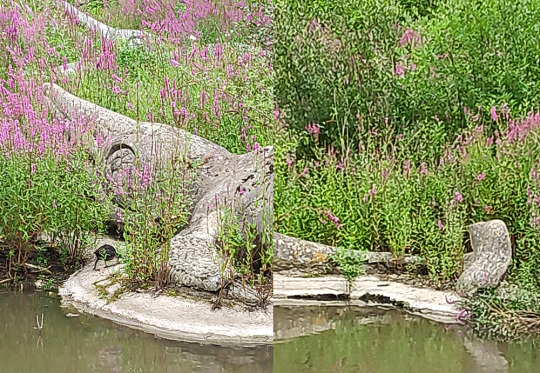
Head, flipper, and tail details of the Temnodontosaurus. A second ichthyosaur is just barely visible in the background.
Ichthyosaurs were already known from some very complete and well-preserved fossils in the 1850s, so a lot of the anatomy here still holds up fairly well even 170 years later. They even have an attempt at a tail fin despite no impressions of such a structure having been discovered yet! Some details are still noticeably wrong compared to modern knowledge, though, such as the unusual amount of shrinkwrapping on the sclerotic rings of the eyes and the bones of the flippers.

———

Arranged around the ichthyosaur, three different Jurassic plesiosaurs are also represented – “Plesiosaurus” macrocephalus with the especially sinuous neck on the left, Plesiosaurus dolichodeirus in the middle, and Thalassiodracon hawkinsi on the right.
They're all depicted here as amphibious and rather seal-like, hauling out onto the shore in the same manner as the ichthyosaurs. While good efforts for the time, we now know these animals were actually fully aquatic, that they had a lot more soft tissue bulking out their bodies, and that their necks were much less flexible.

———
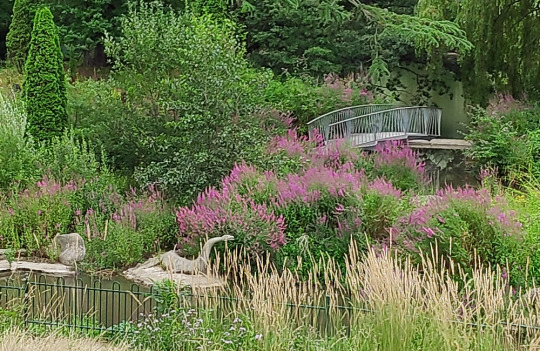
The recently-installed new pivot bridge is also visible here behind some of the marine reptiles.
———

Positioned to the left of the other marine reptiles, this partly-obscured pair of croc-like animals are teleosaurs (Teleosaurus cadomensis), a group of Jurassic semi-aquatic marine crocodylomorphs.

A better view of the two teleosaurs by MrsEllacott (CC BY-SA 4.0)
The Crystal Palace statues have the general proportions right, with long thin gharial-like snouts and fairly small limbs. But some things like the shape of the back of the head and the pattern of armored scutes are wrong, which is odd considering that those details were already well-known in the 1850s.

———
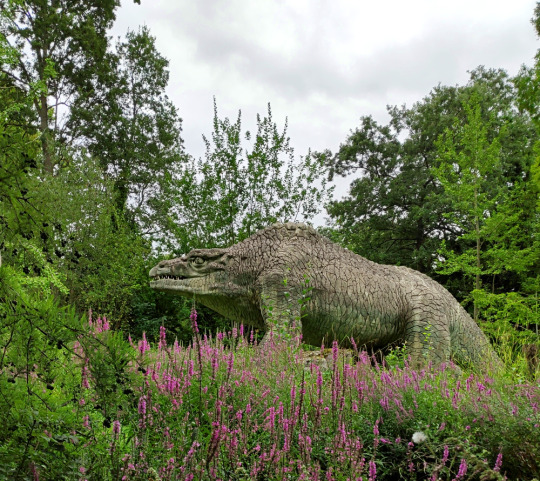
Finally we reach the first actual dinosaur, and one of the most iconic statues in the park: the Jurassic Megalosaurus!
Megalosaurus bucklandi was the very first non-avian dinosaur known to science, discovered in the 1820s almost twenty years before the term "dinosaur" was even coined.
At a time when only fragments of the full skeleton were known, and before any evidence of bipedalism had been found, the Crystal Palace rendition of Megalosaurus is a bulky quadrupedal reptile with a humped back and upright bear-like limbs. It's a surprisingly progressive interpretation for the period, giving the impression of an active mammal-like predator.
This statue suffered extensive damage to its snout in 2020, which was repaired a year later with a fiberglass "prosthesis".

———
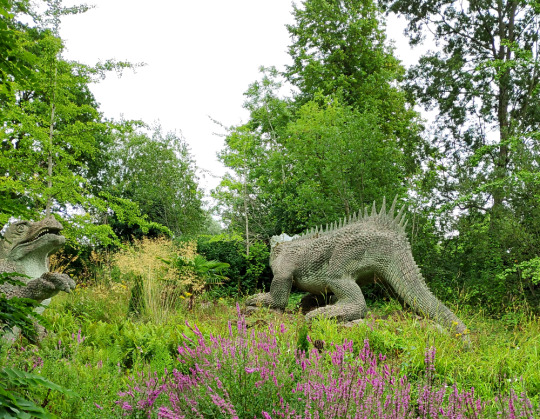
Reaching the Cretaceous period now, we find Hylaeosaurus (and one of the upcoming Iguanodon peeking in from the side).
Hylaeosaurus armatus was the first known ankylosaur, although much like the other dinosaurs here its life appearance was very poorly understood in the early days of paleontology. Considering how weird ankylosaurs would later turn out to be, the Crystal Palace depiction is a pretty good guess, showing a large heavy iguana-like quadruped with hoof-like claws and armored spiky scaly skin.
It's positioned facing away from viewers, so its face isn't very visible – but due to the head needing to be replaced with a fiberglass replica some years ago, the original can now be seen (and touched!) up close near the start of the trail.


———

Two pterosaurs (or "pterodactyles" according to the park signs) were also supposed to be just beyond the Hylaeosaurus, but plant growth had completely blocked any view of them.
Although these two statues are supposed to represent a Cretaceous species now known as Cimoliopterus cuvieri, they were probably actually modeled based on the much better known Jurassic-aged Pterodactylus antiquus.
A second set of pterosaur sculptures once stood near the teleosaurs, also based on Pterodactylus but supposed to represent a Jurassic species now known as Dolicorhamphus bucklandii. These statues went missing in the 1930s, and were eventually replaced with new fiberglass replicas in the early 2000s… only to be destroyed by vandalism just a few years later.
(The surviving pair near the Hylaeosaurus are apparently in a bit of disrepair these days, too, with the right one currently missing most of its jaws.)

Image by Ben Sutherland (CC BY 2.0)
The Crystal Palace pterosaurs weren't especially accurate even for the time, with heads much too small, swan-like necks, and bird-like wings that don't attach the membranes to the hindlimbs. Hair-like fuzz had been observed in pterosaur fossils in the 1830s, but these depictions are covered in large overlapping diamond-shaped scales due to Richard Owen's opinion that they should be scaly because they were reptiles.
But some details still hold up – the individual with folded wings is in a quadrupedal pose quite similar to modern interpretations, and the bird-like features give an overall impression of something more active and alert than the later barely-able-to-fly sluggish reptilian pterosaur depictions that would become common by the mid-20th century.

(Much like the statues themselves, the "modern" reconstruction above is based on Pterodactylus rather than Cimoliopterus)
———

The last actual dinosaurs on this dinosaur trail are the two Cretaceous Iguanodon sculptures. At the time of my visit they weren't easy to make out behind the overgrown trees, and only the back end of the standing individual was clearly visible.

Named only a year after Megalosaurus, Iguanodon was the second dinosaur ever discovered, and early reconstructions depicted it as a giant iguana-like lizard.
The Crystal Palace statues depict large bulky animals, one in an upright mammal-like stance and another reclining with one hand raised up. (This hand is usually resting on a cycad trunk, but that element appeared to be either missing or fallen over when I was there.)
Famously a New Year's dinner party was held in the body of the standing Iguanodon during its construction, although the accounts of how many people could actually fit inside it at once are probably slightly exaggerated.
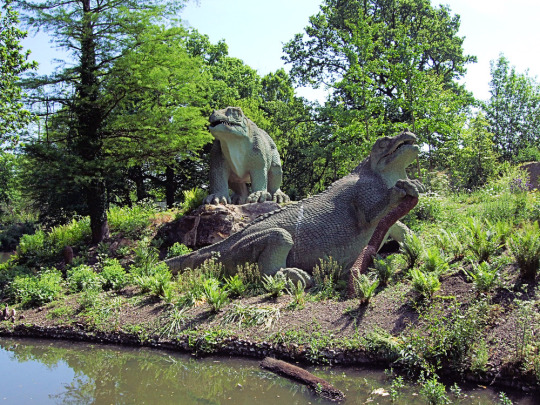
A clearer view by Jim Linwood (CC BY 2.0)
Considering that the skull of Iguanodon wasn't actually known at the time of these sculpture's creation, the head shape with a beak at the front of the jaws is actually an excellent guess. The only major issue was the nose horn, which was an understandable mistake when something as strange as a giant thumb spike had never been seen in any known animal before.

(The fossils the Crystal Palace statues are based on are actually now classified as Mantellisaurus atherfieldensis, but the "modern" reconstruction above depicts the chunkier Iguanodon bernissartensis.)
———
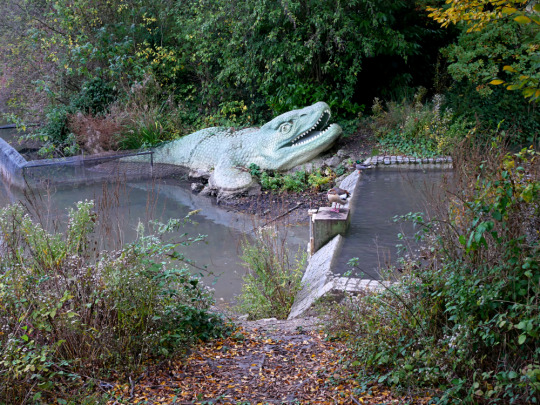
Image by Doyle of London (CC BY-SA 4.0)
I also wasn't able to spot the Cretaceous mosasaur on the other side of the island due to heavy foliage obscuring the view.
Depicting Mosasaurus hoffmannii, this model consists of only the front half of the animal lurking at the water's edge. It's unclear whether this partial reconstruction is due to uncertainty about the full appearance, or just a result of money and time running out during its creation.
The head is boxier than modern depictions, and the scales are too large, but the monitor-lizard like features and paddle-shaped flippers are still pretty close to our current understanding of these marine reptiles. It even apparently has the correct palatal teeth!

Next time: the final Cenozoic section!
#field trip!#crystal palace dinosaurs#retrosaurs#i love them your honor#crystal palace park#crystal palace#ichthyosaur#plesiosaur#teleosaurus#crocodylomorpha#marine reptile#megalosaurus#theropod#hylaeosaurus#ankylosaur#iguanodon#ornithopoda#ornithischia#dinosaur#pterodactyle#pterodactylus#pterosaur#mosasaurus#mosasaur#paleontology#vintage paleoart#art
445 notes
·
View notes
Text
I’m sorry guys, crocs aren’t weirder than any of these :( they’re cool, they’re interesting, they aren’t weird. They’re just doing the semi aquatic predator thing that has been done by many groups throughout history :/
329 notes
·
View notes
Text


Patreon request for Magno/rome.and.stuff - Ichthyovenator laosensis!
Icthyovenator is a Spinosaurid from the Early Cretaceous of Laos. Known only from fragmentary material, it seems to be unique among Spinosaurids for the strange divot in its spine. (In this depiction, I’ve also added another small divot further up the back; however, we don’t have that much of the spine, so this is purely speculative.) This strange sail could have been used for display or species recognition. Like other spinosaurines, Icthyovenator was likely adapted for a semi-aquatic lifestyle, hunting aquatic prey like fish, amphibians, and small dinosaurs. Like Spinosaurus, it had unusually tall vertebral spines on its tail which likely aided in swimming.
While it certainly wasn’t snacking on sauropods (except possibly via scavenging), it lived alongside large ones like Tangvayosaurus. Trackways in the Grès Supérieurs Formation belong to sauropods, iguanodontians, and neoceratopsians, though fish and turtles make up the majority of this ancient habitat.
~~~~~~~~~~~~~
This was a nice warmup for Archovember, and it’s also good to have another Spinosaurid under my belt. I should redraw Baryonyx and give it a size chart. Maybe someday I’ll have enough to make a full spinosaurid comparison chart. 🤔
Btw, the request tier for Patreon starts at only $5 a month. 😉 Link is pinned at the top of my blog.
#Ichthyovenator laosensis#Ichthyovenator#Spinosaur#spinosaurid#theropods#dinosaurs#archosaurs#SaritaDrawsPalaeo#saurischians
90 notes
·
View notes
Note
The "sauropods were too heavy to walk on land and lived in swamps" idea was long debunked, but is it probable some sauropods were semi-aquatic by preference sort of like modern hippos?
It's not impossible, but I don't think we've found any sauropod that's likely to have that kind of lifestyle yet. Hippos are pretty weird creatures and semiaquatic life to that extent produces a lot of changes in the skeletal structure that to my knowledge we haven't seen in any sauropods.
However, there is an iguanodont called Lurdusaurus that might show signs of similar adaptations, with a very wide and round torso and short, stubby legs. It's not certain, but it's possible it could have lived a semi-aquatic life!

Artwork by @paleoart
Image ID: Photorealistic digital illustration of the iguanodont dinosaur Lurdusaurus swimming neck deep in a river. its feet are just brushing the river bottom, sending up clouds of sand. It has a large, round body with four short legs and an unusually long neck for an iguanodont. Water weeds, driftwood, and several fish are visible under the water. End ID.
757 notes
·
View notes
Text
Spectember D3: Atavism
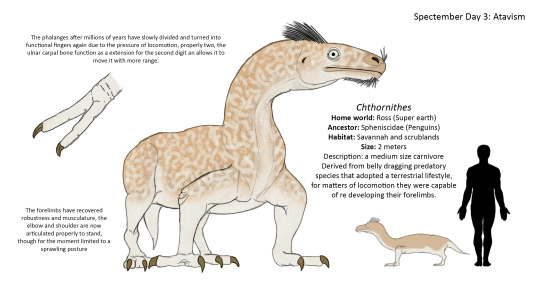
The colony planet "Ross" was a very cold super earth when humans arrived, served as a early settlement for the human interstellar expansion and then as a sanctuary of earth fauna when this was facing an ecological crisis, Ross was populated by different species of penguins that thrived on the conditions, so well that when humans finally disappeared, they kept evolving. Dozens of millions of years the semiaquatic birds managed to conquer the land, establishing as the dominant terrestrial tetrapods, as this world started to get warmer and warmer, and it was until 100 million years something more peculiar happened, something brough back of the ancestry of birds much far behind of dinosaurs, when their ancestors were just semi erect archosauromorphs.
The Chthornithes is sort of return of the “reptilian” condition, resemble little of the semi aquatic creatures that came from, its result of the dry warm climate that have slowly changed its metabolism to an ectotherm, this is a descendant of a branch of belly dragging terrestrial carnivores that properly modified its wings into functional arms, with didactyl and clawed digits that were slowly reforming as they needed proper ways to grasp on the ground, useful for movement now as it can stand on its forelimbs, the skin is covered predominantly of scales, with partial filament like feathers at the top of its neck and head which are remains of their far ancestral feathered forms. These minuscule pebble-like scales, even though looks similar to the earth squamates, aren’t originated similar but derived from feathers adopting something like the feet scales. The head is shaped differently, the beak has shortened, now the lacrimal extend further and leaves the nasal cavity in front making some resemblance to the head of an early theropod, with some rudimentary long blade shaped teeth that allows it to eat small invertebrates and small bird species.
This animal inhabits the large landmass of Ross that formed over the last 50 million years in the equatorial regions, especially in the savannah and scrublands, alongside other peculiar forms of penguin descendants that resemble still birds in many degrees this bizarre animal is a newcomer that could eventually change the landscape of this super earth from bird shaped dominant megafauna to something totally different, if it is capable to survive and leave descendance.
Derived from belly dragging predatory species that adopted a terrestrial lifestyle, for matters of locomotion they were capable of redeveloping their forelimbs, as well for the climate and metabolism have lost most of its feathers that have turned into scales.
The phalanges after millions of years have slowly divided and developed again functional fingers again due to the pressure of locomotion, properly only two with the second using the ulnar carpal bone as a extension for the second digit that allows it to move it with more range. The forelimbs have recovered robustness and musculature, the elbow and shoulder are now articulated properly to stand, though for the moment limited to a semi-sprawled posture.
---------------------------------
This is sort of a old continuation of a piece I made years ago about a terraformed sanctuary world with penguins which it continues the peculiar adaptation these had without any competition apart of themselves

#speculative evolution#future evolution#seed world#terraformed world#penguin#quadrupedal bird#spectember
89 notes
·
View notes
Text

Deviating a bit from the normal style of the paleo art I usually do is this old sketch that I found. A dinosaur not usually in the lime light (Halszkaraptor) and a dinosaur whos been a show runner for quite a bit of time (Spinosaurus). Halszkaraptor was always such a cute Dromaeosaur to me since its basically just a duck/goose raptor. Evidence suggested it was semi-aquatic (though Ive seen articles denying such theories)
I do believe I heard an article get published recently from someone who said Spinosaurus couldnt swim despite having a paddle like tail, teeth made for catching fish, and other aquatic adaptations, but I still like the idea of it swimming. I dont know what it is with older paleontologists trying to refute that some Dinosaurs were semi-aquatic.
20 notes
·
View notes
Text

Spinosaurus (spine lizard) was a massive semi-aquatic predator from north Africa during the late Cretaceous period (99-93.5 Mya). The animal is thought to have measured about 49 feet, placing it among the largest theropod dinosaurs. Spinosaurus was originally discovered and named by German Paleontologist Ernst Stromer von Reichenbach in 1915. Tragically however, the original Spinosaurus skeleton, along with Stromer's other dinosaur specimens, were destroyed in a bombing of Munich during World War 2. Since then, more discoveries have been made, but recreating Spinosaurus is an ongoing puzzle.
Based on our current understanding of the animal, Spinosaurus had jaws similar to that of a crocodile, implying a diet of mostly fish. It had a thick paddle-like tail for swimming, and of course the iconic sail along its spine that gives it its name.
#spinosaurus#paleoart#paleontology#evolution#dinosaur#dinosaurs#birds#theropod#reptile#reptiles#animal#animals#animal art#zoology
29 notes
·
View notes
Text


[id: a photo of spinosaurus, a large semi-aquatic theropod with a sail on its back, and ankylosaurus, a large quadrupedal armored dinosaur with a bony club on its tail. end id]
okay this is it!!! we will know tomorrow which dinosaur is officially the coolest!!! great job to all the contestants and thanks for participating!!!
187 notes
·
View notes
Text
Fossil Crocs of 2022
For what its worth, its been a great year for fossil Pseudosuchians, many of which didn't get a lot of attention because people always assume its just "another crocodile". We'll go through them by the order of appearance in the fossil record, or in other words oldest to youngest. Better grab some popcorn and the drink of your choice, cause this is going to be a long one.
Mambawakale
Starting off is Mambawakale ruhuhu (Ruhuhu Basin Crocodile Ancestor in Kiswahili) from the middle Triassic Manda Beds of Tanzania. The fossils for this guy had been known since at least the 1960s, after which it was named Pallisteria angustimentum, a name that was never officially published however. It was a large animal, its skull 75 centimeters long attached to what was likely an animal similar in build to what we think of for "rauisuchians", given that it sits at the base of Paracrocodylomorpha. The below life reconstructoin was done by the fantastic Gabriel Ugueto with Steve Irwin inserted in post by me, tho its not rigorously scaled it gives a general idea of the animal's size.
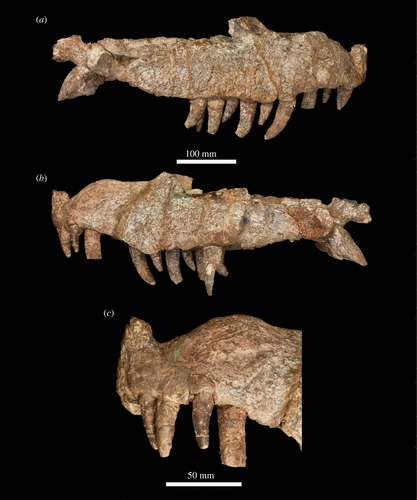
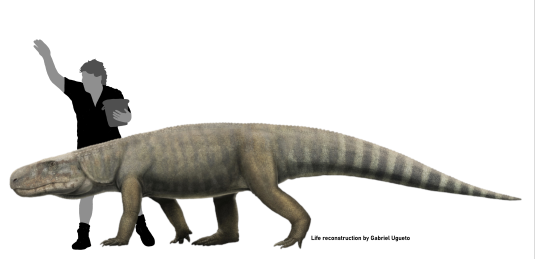
We can then skip over the Jurassic (no new crocs from that period) and straight into the Cretaceous, specifically the Albian some 100 million years ago.
Yanjisuchus
Yanjisuchus longshanensis (Yanji City Crocodile from the Longshan Hill) was a paralligatorid, a group of Neosuchians I fully admitt I'm not too well aquainted with. Its fossils, which include a partial skull, vertebrae osteoderms, ribs, parts of the shoulder girdle and front limbs, were discovered in the Longjing Formation in what is now north-eastern China.

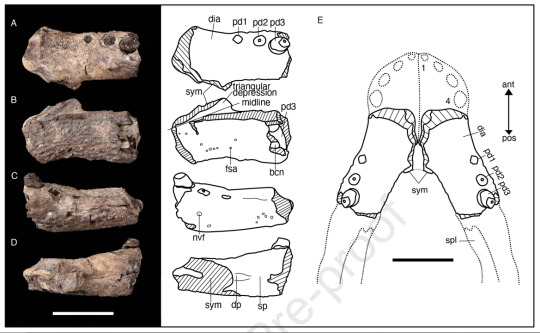
Confractosuchus
One I can decidedly talk more about is Confractosuchus sauroktonos (Lizard Eating Broken Crocodile) from the Australian Winton Formation, home to animals such as Isisfordia, Australovenator and Diamantinasaurus. The genus name refers to the fact that the skull is squashed to hell and back, but its the species name thats interesting. "Lizard eating" in this case refers to the fact that this 2.5 meter long basal Eusuchian was found with preserved stomach contents. Said stomach contents being the bones of a small ornithopod dinosaur as the press release art by Julius Csotonyi enthusiastically shows. The other image here not from the paper was drawn by Joschua Knüppe (@knuppitalism-with-ue ) showing a definitely more relaxed individual.

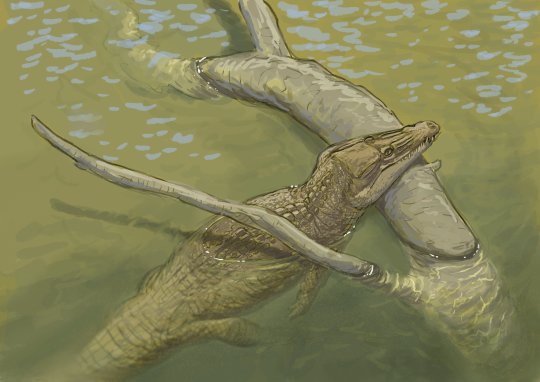

Eptalofosuchus
We did know about this guy for a bit longer as the pre-proof has been out since 2021, but lets include it anyways because I wasn't on Tumblr last year. Eptalofosuchus viridi (Green Seven Hills Crocodile) is not a crocodile in the strict sense but a Notosuchian, a cousin to the more typical Neosuchians. This animal is known from a single distinct lower jaw that belonged to a rather small creature. Among Notosuchians, Eptalofosuchus is most closely related to "advanced Notosuchians", specifically Sphagesauridae. We also know that it wasn't alone, as described alongside it are fossils of an unnamed baurusuchid (a large carnivore) and a peirosaurid, a more basal Notosuchian. Finally, both parts of the scientific name allude to the Uberaba Formation, specifically the nickname of Uberaba being “the city of the seven hills” and the green color of the sediments there. Life reconstruction of the little guy was done by the always incredible Júlia d'Oliveira.
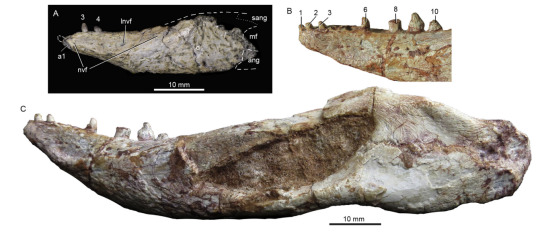
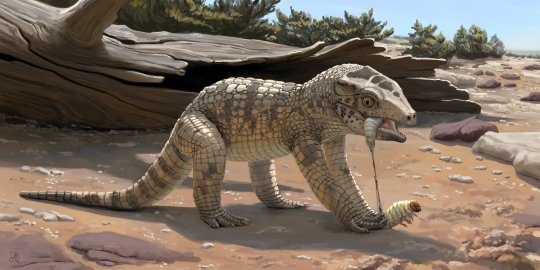
Titanochampsa
Sticking to South America we have Titanochampsa iorii (Ior's Titan Crocodile). A significant find no doubt tho with an estimated size between 2.98–5.88 m (sizable I admitt) based on very scant remains perhaps a little bit hasty. Alas we only have the skull table of this animal, so the precise size can still vary as you can see. But it is still a fascinating one due to the fact that its the ONLY non-Notosuchian from the Bauru Group. Cretaceous South America is almost synonymous with these mostly terrestrial crocodyliforms but surprisingly lacking a diverse semi-aquatic croc fauna. Being at the very least a Neosuchian, possibly Eusuchian, Titanochampsa seems to have filled this niche. Given that the big terrestrial Baurusuchids had relatively weak bites and reached a length of at most 4 meters, this presents an interesting contrast with the strong bite force of the potentially larger semi-aquatic Titanochampsa. And would you look at that, press release art by Júlia once again.
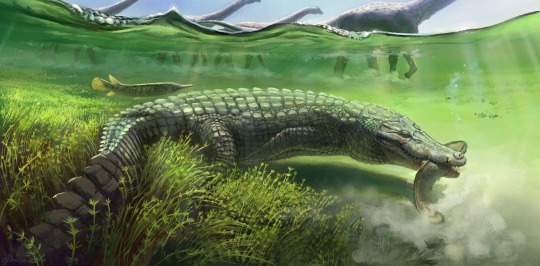

Eurycephalosuchus
One final croc for the Mesozoic, Eurycephalosuchus gannanensis is an animal I covered very recently so I'll keep things brief. Stemming from the Maastrichtian Hekou Formation in south eastern China, Eurycephalosuchus was a very small species of orientalosuchine. Orientalosuchina is recovered as a group of early alligatoroids in the paper, tho talking to Adam Yates (who's croc phylogeny is my go-to) there is a chance they might be closer to crocodiloids. Regardless, Eurycephalosuchus was a small animal with large teeth towards the front of the skull, blunt teeth in the back and an overall very short face (tho there is slight compression so its not 1:1 like the fossil). Over on twitter people started comparing it to DnD Kobolds, leading to the below artwork by Manusuchus (@ mmujicam2000; full body of course highly speculative lmao)
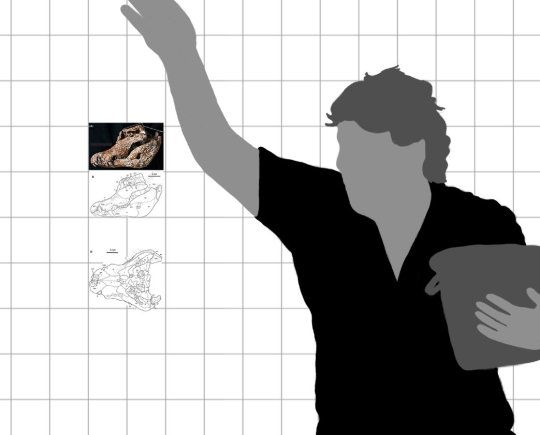

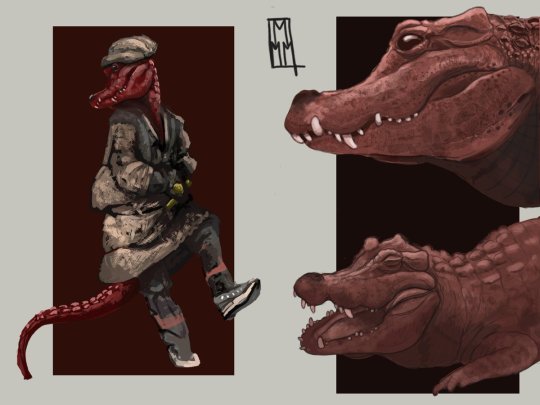
Qianshanosuchus
Following the cataclysm that was KPG, crocs held on and in China we next meet Qianshanosuchus youngi (Young's Qianshan Basin Crocodile). It's another tricky one. While important as being the first crocodyloid from Paleocene China, the material, as you could guess based on the tiny size, is that of a juvenile (I now realize this being kinda ironic given the small but adult croc above). So the phylogeny is hard to nail down and gave different results. Still it could hold significance in our understanding how crocodyloids spread around the world and entered Europe after KPG. Below a quick comparison of the material with my hand.

Coming up a duo of two new species but not new genera, I also didn't really go deep into their publication as with some of the others so I'll try to stay brief
Maomingosuchus acutirostris
Maomingosuchus acutirostris (Acute Snouted Maoming Crocodile) is a new species of the already established genus Maomingosuchus from China. This new species however, differentiated amongst other things by having a pointed, not rounded, premaxilla stems from the Eocene of northern Vietnam. The skull is about 55 cm long giving us a medium sized tomistomines. Like Qianshanosuchus, M. acutirostris could have implications for the dispersal of crocodilians, in this case the spread of tomistomines from Europe to Asia, which the authors suggest happened thrice. That being said it should be noted that, between the two main ideas of what tomistomines are, the paper goes with them being a sister group to crocs and unrelated to modern gharials as Lee and Yates suggest (the later idea like I said I am more drawn towards).


Diplocynodon kochi
Another new species in a familiar genus, Diplocynodon kochi (Koch's Double Dog Tooth) is the latest in a long list of Diplocynodon species, a genus of alligatoroid very prominent in the Paleogene of Europe. This newest species from Transylvania is known from some well preserved skull material and was recovered as being one of the most derived members of its genus. With a size of 1.76 meters it was a medium sized Diplocynodon species and small by our modern standards. What is interesting is that the fossilw as recovered from shallow marine sediments. This is unusual in so far that alligatoroids are not especially known for their salt tolerance. Tho there's exceptions like Deinosuchus, alligators usually don't venture into salt water unlike crocodiles. Still, given the shallow water and the ability of large adult Mississippie Alligators to tolerate brackish water, it might have occasionally entered coastal waters. It is noted that the skull is in such good condition that it couldn't have been transported for a very long time.
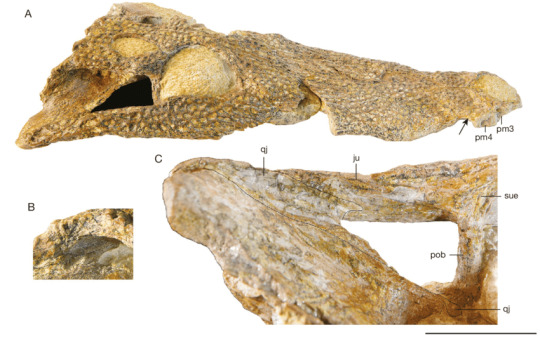
Kinyang
Back to new genera we got Kinyang (derived from various Nilotic terms for crocodile), a genus of "giant" dwarf crocodile from the Miocene of Kenya. Now this guy doesn't just introduce one new species but two: Kinyang mabokoensis (Maboko Island Crocodile) and Kinyang tchernovi (Tchernov's Crocodile). Occuring in western and northern Kenya, Kinyang was a prime example over the prominence osteolaemines (dwarf crocodiles) had in the early Cenozoic prior to the takeover of crocodylines. Kinyang was surprisingly large and had a robust, blunt skull with several traits clearly setting it apart from any modern species. Still there is some clues that could be taken. Given the robust nature and more widened skull rather than V-shaped, its likely that it went after prey as big or even bigger than itself. They appear to have inhabited the shores of lakes located in open forests and woodlands. Alas this might have been their doom too. Osteolaemines are known to build nests made of foliage and with Africa growing increasingly dryer around this point in earths history, both change in prey and environment could have been factors that drove the dwarf crocodiles into the rainforests they inhabit today while the more dry resistant Crocodylus took over their rolle in the grasslands. The first image shows all three known skulls, the second is a quick composite of the cranium and mandible of K. mabokoensis I put together before the third image was published (ironic) by Christopher Brochu.
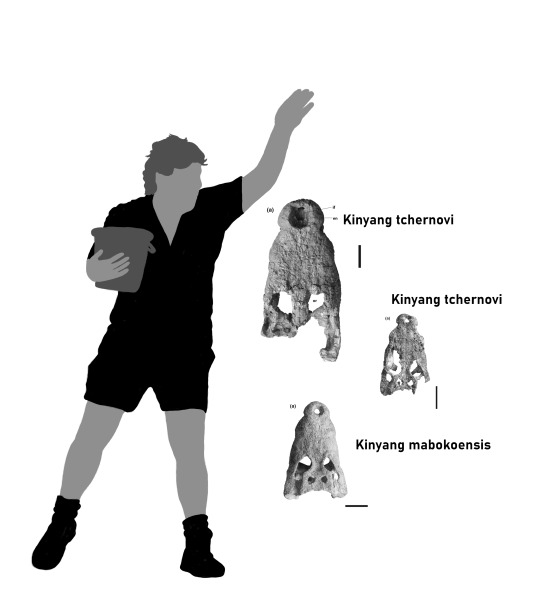
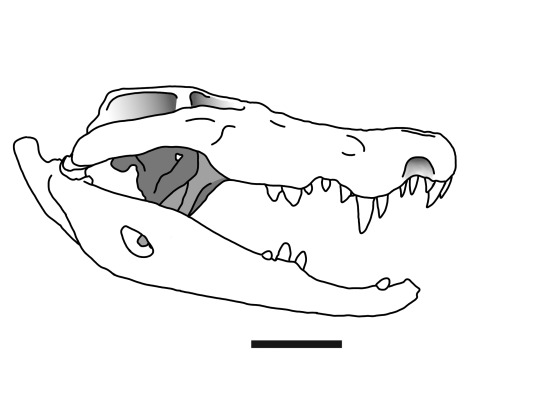

Almost done, only two more to go.
Sacacosuchus
On the other side of the world, specifically the Sacaco locality of Peru's Pisco Formation (among others) we have Sacacosuchus cordovai (Córdova's Sacaco Crocodile). A medium sized and longirostrine "tomistomine" gharial, here is where we come in conflict between the crocodylid and gavialoid model of what these guys are. Earlier with Maomingosuchus you had the idea that tomistomines were related to crocodylids, well here we have tomistomines being a paraphyletic group leading up to derived gharials. There is some significance to Sacacosuchus for seemingly showing that gharials entered South America on two separate occassions, but imo that's not the coolest thing about it. No instead I prefer to talk about the fact that its not just a marine gharial, living in the coastal waters of the Pacific, but that it coexisted with a second gharial showing perfectly how they specialise in different things. While the contemporary Piscogavialis was notably larger (about 7 meters) it had a very narrow and long snout, better adapted at catching fish. Sacacosuchus meanwhile was only 4.3 meters long, but with much more robust jaws, showing that it was much more of a generalist than its relative. This is well shown in the reconstruction by Javier "Canelita" Herbozo, tho it doesn't show the immense size difference. The third iamge shows Rodolfo Salas-Gismondi with the material and the fourth illustration by Gabriel Ugueto does not feature Sacaco, but the much more gracile Piscogavialis.




Hanyusuchus
The final one, Hanyusuchus sinensis (Han Yu's Crocodile from China) is the youngest crocodile described this year. How young? Well the OLDEST records of the species date to the Chinese Bronze Age, 4.000 BC, while the most recent records indicate that it went extinct in the 15th century. Hanyusuchus is a large tomistomine with a length between 5.43–6.19 meters and, if historical reports are to be believed, a big appetite. Stories tell of large crocodiles in Southern China attacking livestock, deer, boats and even killing humans while other reports suggest that these animals were used to fill moats and fed with prisoners. Despite appearing relatively narrow snouted, people often underestimate just how dangerous such animals could be. Even the modern false gharial has reports of it attacking and eating humans. Unsurprisingly, in addition to spawning some unique folklore (like crocodiles turning into tigers during autumn), this lead to humans attacking and killing these animals in retaliation. Fossils from the Bronze Age bear the clear marks of human attacks with cut marks focused around the animals head and the neck. Given the age of this material humans likely used bronze axes to kill and decapitate Hanyusuchus, drying their heads afterwards. Things didn't get better later in history. Han Yu, poet and politician and namesake of the genus, once demanded that the crocodiles leave the Han River delta before threatening to kill them. Later in history soldiers were sent to kill them in masses to avenge the death of a child. Eventually all of this, coupled with habitat loss, lead to the extinction of Hanyusuchus a mere 600 years ago. The below reconstructions were done by Hikaru Amemiya and Joschua Knüppe respectively.


And that is basically every crocodile officially published in 2022 (I think). Personally, I think its been a fantastic year for Pseudosuchian taxa, with some unique and fascinating additions.
#crocodiles#palaeoblr#mambawakale#hanyusuchus#sacacosuchus#kinyang#qianshanosuchus#eurycephalosuchus#diplocynodon kochi#maomingosuchus acutirostris#titanochampsa#confractosuchus#eptalofosuchus#yanjisuchus#prehistory#paleontology#pseudosuchia#steve irwin for scale#2022
173 notes
·
View notes
Note
monnie what is the new spinosaurus controversy
Basically it's just every couple months a new paper comes out with very conflicting information on whether it was or wasn't a fully aquatic dinosaur. Recently a paper came out studying an Irritator/Spinosaurus jaw which discovered it's jaw was able to open similar to a pelican's. It also had a fast but weak bite according to the paper. Which backs up that it may have been semi to fully aquatic. Which directly contradicts the last major paper released that stated Spinosaurus wasn't an aquatic dinosaur and probably wasn't capable of swimming
#its so confusing lmao#at this point im just like#make spinofaarus canon#itd be the funniest route#monnie answers
56 notes
·
View notes
Text
Crystal Palace Field Trip Part 3: Walking With Victorian Beasts
[Previously: the Jurassic and Cretaceous]
The final section of the Crystal Palace Dinosaur trail brings us to the Cenozoic, and a selection of ancient mammals.
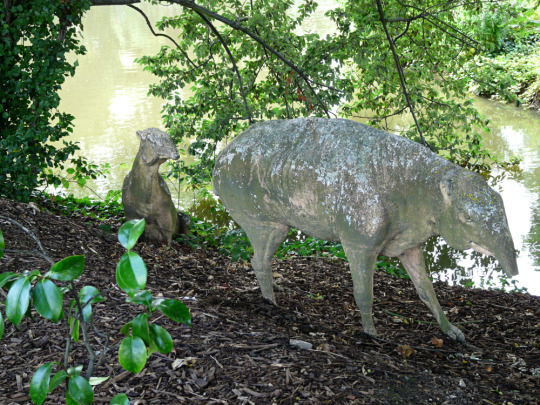
Image from 2009 by Loz Pycock (CC BY-SA 2.0)
Originally represented by three statues, there are two surviving originals of the Eocene-aged palaeotheres depicting Plagiolophus minor (the smaller sitting one) and Palaeotherium medium (the larger standing one).
The sitting palaeothere unfortunately lost its head sometime in the late 20th century, and the image above shows it with a modern fiberglass replacement. Then around 2014/2015 the new head was knocked off again, and has not yet been reattached – partly due to a recent discovery that it wasn't actually accurate to the sculpture's original design. Instead there are plans to eventually restore it with a much more faithful head.
These early odd-toed ungulates were already known from near-complete skeletons in the 1850s, and are depicted here as tapir-like animals with short trunks based on the scientific opinion of the time. We now think their heads would have looked more horse-like, without trunks, but otherwise they're not too far off modern reconstructions.
There was also something exciting nearby:

The recently-recreated Palaeotherium magnum!
This sculpture went missing sometime after the 1950s, and its existence was almost completely forgotten until archive images of it were discovered a few years ago. Funds were raised to create a replica as accurate to the original as possible, and in summer 2023 (just a month before the date of my visit) this larger palaeothere species finally rejoined its companions in the park.
Compared to the other palaeotheres this one is weird, though. Much chonkier, wrinkly, and with big eyes and an almost cartoonish tubular trunk. It seems to have taken a lot of anatomical inspiration from animals like rhinos and elephants, since in the mid-1800s odd-toed ungulates were grouped together with "pachyderms".
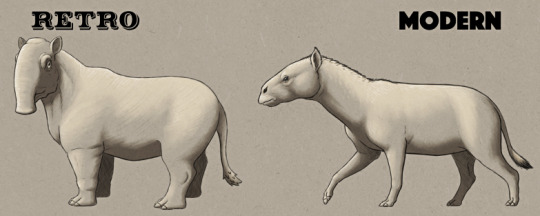
———
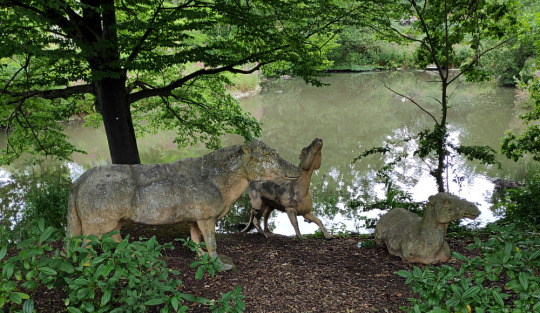
Next is Anoplotherium, an Eocene even-toed ungulate distantly related to modern camels.
(Apparently the sculpture closest to the water is a replica of a now-lost original, recreated from photo references in the same manner as the new Palaeotherium magnum. I can't find a definite reference for when this one was done, though – I'd guess probably during the last round of major renovations in the early 2000s, at the same time as the now-destroyed Jurassic pterosaur replicas?)
Anoplotherium commune is a rather obscure species today, but it was one of the first early Cenozoic fossil mammals to be recognized by science in the early 1800s. Depicted here as small camel-like animals, the three statues are positioned near the water's edge to reflect the Victorian idea that they were semi-aquatic based on their muscular tails.
Today we instead think these animals were fully terrestrial, using their tails to balance themselves while rearing up to reach higher vegetation. Their heads would also have looked a bit less camel-like, but otherwise the Crystal Palace trio are still really good representations.
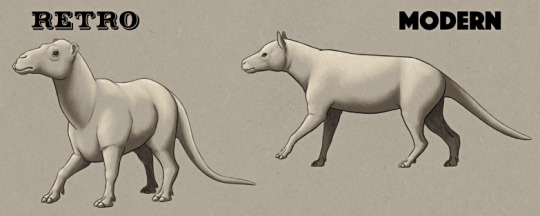
———

Next is a sculpture that's very easy to miss in the current overgrown state.
Who's that peeking over the bushes?
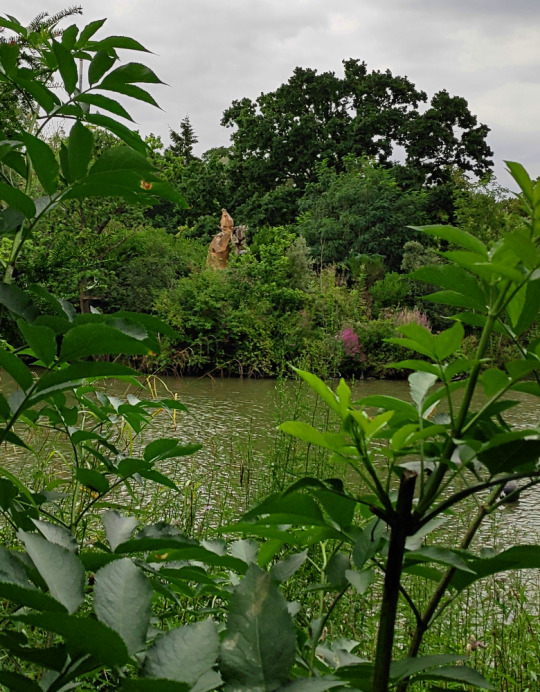
Going all the way around to the far side of the lake reveals a distant glimpse of the Pliocene-to-Holocene giant ground sloth Megatherium.
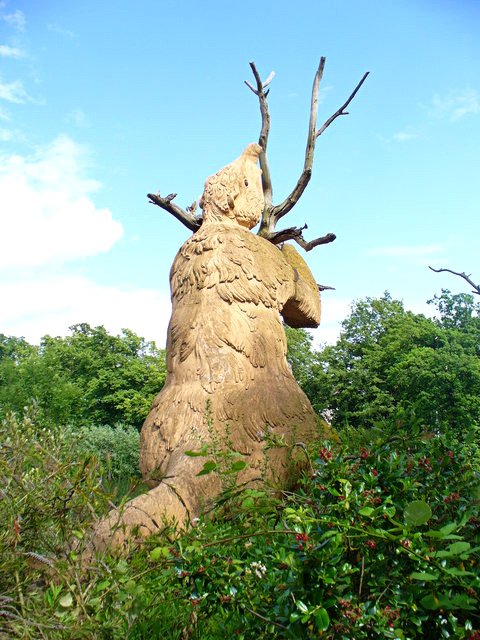
A better view of the Megatherium | "Tree Hugger" by Colin Smith (CC BY-SA 2.0)
Fossils of Megatherium americanum had been known since the late 1700s, but the 1854 Crystal Palace statue was still one of the first life reconstructions of this animal. Its anatomy is actually very close to our modern understanding, depicted with correctly inward-turned feet and sitting upright to feed on a tree with its tail acting as a "tripod".
However, we now know it didn't have a trunk-like nose, but instead probably had prehensile lips more like those of a modern black rhino.
Something weird also appears to have happened to the Crystal Palace Megatherium's hands. Early illustrations of the sculpture all consistently show it with the typical long claws of a sloth, but today it's missing its right hand and its left has only a strangely stumpy paw – suggesting that at some point in the intervening 170 years there was an unrecorded crude repair.
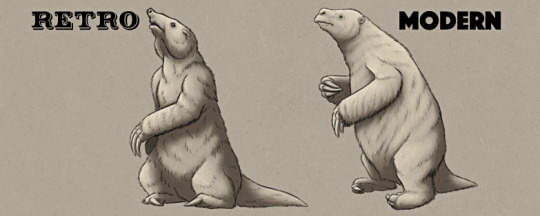
———
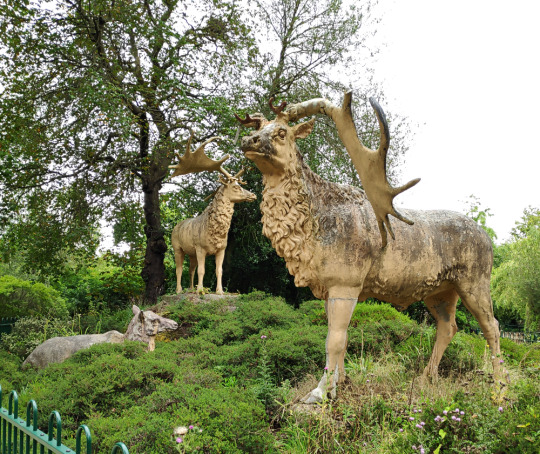
And finally we end the trail with three Megaloceros, the Pleistocene-to-Holocene "Irish Elk" that's actually neither exclusively Irish nor an elk.
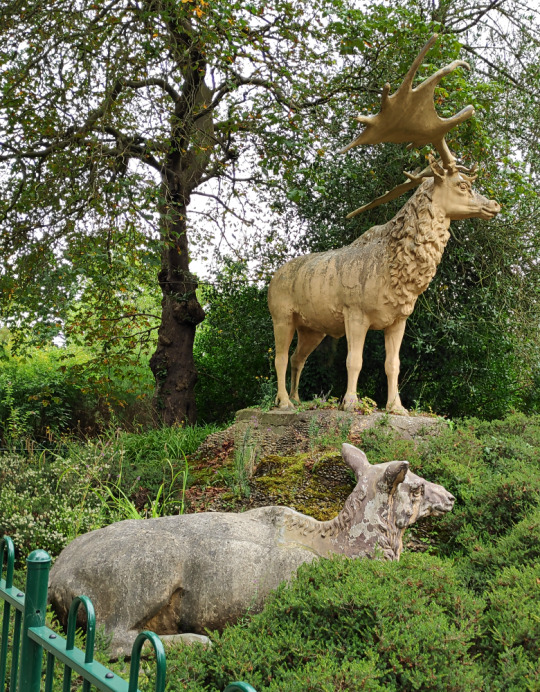
A closer look at the second stag and the doe.
There was originally a fourth giant deer sculpture in this herd, a second resting doe, but it was destroyed sometime during the mid-20th century. The stags also initially had real fossil antlers attached to their heads, but these were removed and replaced with less accurate versions at some point by the mid-20th century.
One of the stags' antlers suffered some damage in 2020, ending up drooping, and since then one antler has either fallen off or been removed.
In the 1850s Megaloceros giganteus was thought to be closely related to deer in the genus Cervus, and so the Crystal Palace reconstructions seem to be based on modern wapiti – specifically in their winter coats, fitting for ice age animals – since both the stags and the doe sport distinctive thick neck manes.
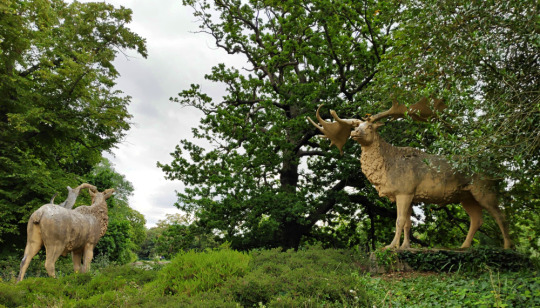
The stags from the other side.
We now know Megaloceros was actually much more closely related to modern fallow deer, and so probably resembled them more than wapiti. Cave art also shows that it had a hump on its shoulders, and even gives us an idea of what its coloration was.
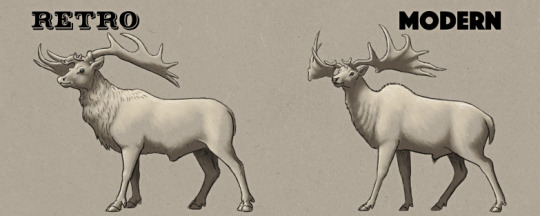
———
…But wait!
There's actually one more thing.
A small statue sitting on the far side of the deer herd, missing its ears, and seemingly representing a Megaloceros fawn.
Except it's actually something very different and very special.
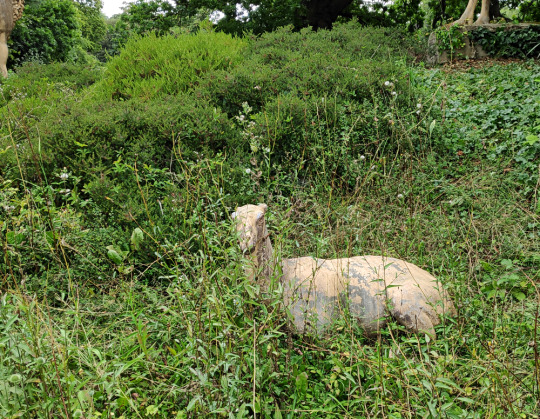
Ceci n'est pas un cerf.
Some recent investigation work revealed some surprising information about the Crystal Palace mammal statues – much like the nearly-forgotten large Palaeotherium, there was originally an entire group of four small Eocene-aged llama-like Xiphodon gracilis that had disappeared from living memory.
There was also no historic record of a fawn with the giant deer, but instead a suspiciously similar-looking sitting sculpture is illustrated among what we now known are the four missing Xiphodon in early records.
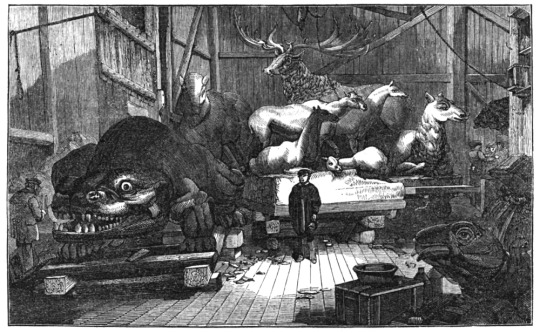
An 1853 illustration of the sculpture workshop. The four Xiphodon are shown in the center, directly in front of a Megaloceros stag and doe. (public domain)
Somewhere in the late 19th or early 20th century three of the Xiphodon must have been completely lost, and the remaining individual was misidentified as a fawn and placed with the giant deer herd.
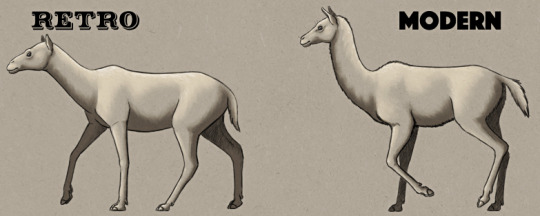
———
Rediscovering a whole extra species among the Crystal Palace statues is exciting, but it also demonstrates just how much of these sculptures' history has gone completely undocumented.
The mammal statues especially seem to have suffered the most out of the "Dinosaur Court", being often overlooked, neglected, disrespected (at one point the Megatherium was inside a goat pen in a petting zoo!), and subjected to cruder repairs. A total of five original statues are now known to be missing from this Cenozoic section – the original large Palaeotherium, the three other Xiphodon, and the second Megaloceros doe – compared to the two pterosaurs lost from the Mesozoic island.
Hopefully the excellent recreation of the lost Palaeotherium magnum is the start of a long overdue new lease of life and conservation attention for all of the Crystal Palace sculptures. It was disappointing seeing them all in such an overgrown state, and with signs of ongoing disrepair in places such as the plant growing out of the big ichthyosaur's back.
But there has been some resurgence of interest and public attention in the Crystal Palace sculptures over the last few years, so with any luck these historic pieces of early paleoart will survive on to their 200th anniversary and beyond, to keep on reminding us of where things began and how far our understanding of prehistoric life has since come.
#field trip!#crystal palace dinosaurs#retrosaurs#i love them your honor#crystal palace park#crystal palace#palaeotherium#anoplotherium#xiphodon#ceci n'est pas un cerf#megaloceros#ungulate#megatherium#ground sloth#mammal#paleontology#vintage paleoart#art#proper art post tomorrow#this took longer than expected#also apologies for my potato-quality camera#i'm an illustrator not a photographer
321 notes
·
View notes
Note
Another reason I think people don't understand that birds are dinosaurs is because they see evolution as "one thing changing into another" which... isn't exactly true if you know what I mean.
Humans didn't "evolve from apes" we ARE apes. We never left the category that includes chimps and bonobos. We also never left the category of mammal or synapsid.
A lot of documentaries have also used easier words for the sake of simplicity and it unintentionally led to some misunderstanding. We didn't "evolve from reptiles" and we didn't "evolve from amphibians". Not in the actual taxonomical sense. If you define a reptile as a creature with scales that lays eggs then, yeah. If you define an amphibian as a semi-aquatic creature with slimy skin, then yeah. But the actual concrete definition of those terms? No, we didn't evolve from reptiles and amphibians. Don't even get me started on the useless term "fish"
yeah, a misunderstanding of how evolution works is definitely partly to blame
I also blame hollywood for emphasizing "dinosaur = reptilian monster" to a truly horrifying degree
127 notes
·
View notes
Text
Random Fact #6,463
Spinosaurus is the only known semi-aquatic dinosaur.
Part of the reason we know it was semi-aquatic is the shape of its head, which looks very similar to a croc’s or a hippo's (with the eyes at the top of its head and the nose further up its muzzle so that they can remain mostly submerged).
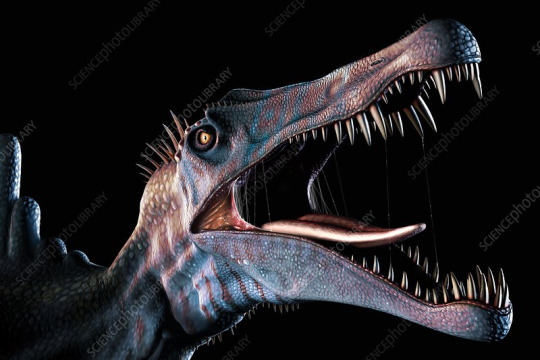
#dinosaur facts#dinosaurs#paleontology#spinosaurus#did you know#random factoid#random fact#random facts#little known fact#random factoids#yes really#biology
65 notes
·
View notes